 W
WA single-board computer (SBC) is a complete computer built on a single circuit board, with microprocessor(s), memory, input/output (I/O) and other features required of a functional computer. Single-board computers are commonly made as demonstration or development systems, for educational systems, or for use as embedded computer controllers. Many types of home computers or portable computers integrate all their functions onto a single printed circuit board.
 W
WA stick PC or PC on a stick is a single-board computer in a small elongated casing resembling a stick, that can usually be plugged directly into an HDMI video port. A stick PC is a device which has independent CPUs or processing chips and which does not rely on another computer. It should not be confused with passive storage devices such as thumb drives.
 W
WThe Arndale Board is a high-power single-board computer featuring the ARM Cortex-A15 MPCore developed in South Korea.
 W
WThe ASUS Tinker Board is a single board computer launched by ASUS in early 2017. Its physical size and GPIO pinout are designed to be compatible with the second and third-generation Raspberry Pi models. The first released board features 4K video, 2GB of onboard RAM, gigabit Ethernet and a Rockchip RK3288 processor running at 1.8 GHz.
 W
WThe BeagleBoard is a low-power open-source single-board computer produced by Texas Instruments in association with Digi-Key and Newark element14. The BeagleBoard was also designed with open source software development in mind, and as a way of demonstrating the Texas Instrument's OMAP3530 system-on-a-chip. The board was developed by a small team of engineers as an educational board that could be used in colleges around the world to teach open source hardware and software capabilities. It is also sold to the public under the Creative Commons share-alike license. The board was designed using Cadence OrCAD for schematics and Cadence Allegro for PCB manufacturing; no simulation software was used.
 W
WThe Bus Pirate is a universal bus interface device designed for programming, debugging, and analyzing microcontrollers and other ICs. It was developed as an open-source hardware and software project.
 W
WThe Calliope mini is a single-board computer developed for educational usage at German primary schools. The goal of the initiative is to provide all pupils as of grade three of primary schools in Germany with a Calliope mini free of charge.
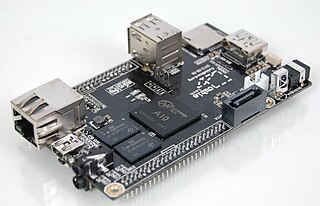 W
WCubieboard is a single-board computer, made in Zhuhai, Guangdong, China. The first short run of prototype boards were sold internationally in September 2012, and the production version started to be sold in October 2012. It can run Android 4 ICS, Ubuntu 12.04 desktop, Fedora 19 ARM Remix desktop, Armbian, Arch Linux ARM, a Debian-based Cubian distribution, FreeBSD, or OpenBSD.
 W
WCuBox and CuBox-i are series of small and fanless nettop-class computers manufactured by the Israeli company SolidRun Ltd. They are all cube-shaped and sized at approximately 2 × 2 × 2 inches and weigh 91 grams. CuBox was first announced in December 2011 and began shipping in January 2012, initially being marketed as a cheap open-source developer platform for embedded systems.
 W
WThe GMC-4 is the only 4-bit microcomputer to be mass-produced in the last 30 years. It was produced by Gakken, a Japanese publisher who distributed it with a magazine attached to a box containing the components required to assemble the computer.
 W
WGoWarrior is an open-source and community-supported computing platform. GoWarrior is designed for the world of makers, hackers, educators, hobbyists, and newbies to build electronics projects. It offers a complete package of hardware, software and cloud service.
 W
WGumstix is an American multinational corporation headquartered in Redwood City, California. It develops and manufactures small system boards comparable in size to a stick of gum. In 2003, when it was first fully functional, it used ARM architecture System on a chip (SoC) and an Operating System based on Linux 2.6 kernel. It has an online tool called Geppetto that allows users to design their own boards. In August 2013 it started a crowd-funding service to allow a group of users that want to get a custom design manufactured to share the setup costs.
 W
WCreator is a family of single-board computers developed by Imagination Technologies to promote educational research and software development based on the MIPS architecture. The first board in the platform, the Creator Ci20, was released in August 2014. A second development kit called Creator Ci40 was introduced through a Kickstarter campaign in November 2015.
 W
WThe Intel Compute Stick is a stick PC designed by Intel to be used in media center applications. According to Intel, it is designed to be smaller than conventional desktop or other small-form-factor PCs, while offering comparable performance. Its main connector, an HDMI 1.4 port, along with a compatible monitor and Bluetooth-based keyboards and mice, allows it to be used for general computing tasks.
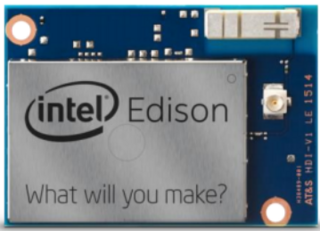 W
WThe Intel Edison is a computer-on-module that was offered by Intel as a development system for wearable devices and Internet of Things devices. The system was initially announced to be the same size and shape as an SD card and containing a dual-core Intel Quark x86 CPU at 400 MHz communicating via Bluetooth and Wi-Fi. A later announcement changed the CPU to a 500 MHz Silvermont dual-core Intel Atom CPU, and in September 2014 a second version of Edison was shown at IDF, which was bigger and thicker than a standard SD card.
 W
WIntel Galileo is the first in a line of Arduino-certified development boards based on Intel x86 architecture and is designed for the maker and education communities. Intel released two versions of Galileo, referred to as Gen 1 and Gen 2. These development boards are sometimes called "Breakout boards".
 W
WIOIO is a series of open source PIC microcontroller-based boards that allow Android mobile applications to interact with external electronics. The device was invented by Ytai Ben-Tsvi in 2011, and was first manufactured by SparkFun Electronics. The name "IOIO" is inspired by the function of the device, which enables applications to receive external input ("I") and produce external output ("O").
 W
WTegra is a system on a chip (SoC) series developed by Nvidia for mobile devices such as smartphones, personal digital assistants, and mobile Internet devices. The Tegra integrates an ARM architecture central processing unit (CPU), graphics processing unit (GPU), northbridge, southbridge, and memory controller onto one package. Early Tegra SoCs are designed as efficient multimedia processors, while more recent models emphasize performance for gaming and machine learning applications, without sacrificing power efficiency.
 W
WThe Micro Bit is an open source hardware ARM-based embedded system designed by the BBC for use in computer education in the United Kingdom. It was first announced on the launch of BBC's Make It Digital campaign on 12 March 2015 with the intent of delivering 1 million devices to pupils in the UK. The final device design and features were unveiled on 6 July 2015 whereas actual delivery of devices, after some delay, began in February 2016.
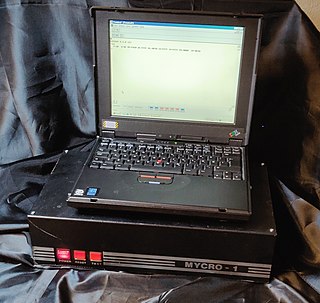 W
WThe MYCRO-1 was a microcomputer manufactured and sold by Mycron of Oslo, Norway. Built around the Intel 8080 CPU, it was one of the first commercial single-board computer after the Intel SDK-80. One is currently displayed at the Norwegian Museum of Science and Technology.
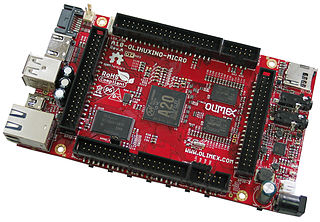 W
WOLinuXino is an open hardware single-board computer capable of running Android or Linux designed by OLIMEX Ltd in Bulgaria.
 W
WThe Onion Omega series of personal single-board computer created by a startup company called Onion that is based in Boston, Toronto and Shenzhen. It is advertised as "the world's smallest Linux Server". The system combines a tiny form factor and power-efficiency with the power of a general purpose Operating System. They ship with a Linux kernel based lightweight operating system for embedded systems called OpenWRT, but is capable of running other lightweight Unix-based operating systems.
 W
WThe PandaBoard was a low-power single-board computer development platform based on the Texas Instruments OMAP4430 system on a chip (SoC). The board has been available to the public at the subsidized price of US$174 since 27 October 2010. It is a community supported development platform.
 W
WPinebook is a lightweight, low-cost notebook designed and manufactured by the company Pine64. It was announced in November 2016 and production started in April 2017. It is based on the platform of Pine64's existing Pine A64 single board computer and it costs US$89 or US$99 for the 11.6" and 14" model respectively. Its appearance resembles the MacBook Air.
 W
WThe RAD750 is a radiation-hardened single board computer manufactured by BAE Systems Electronics, Intelligence & Support. The successor of the RAD6000, the RAD750 is for use in high radiation environments experienced on board satellites and spacecraft. The RAD750 was released in 2001, with the first units launched into space in 2005.
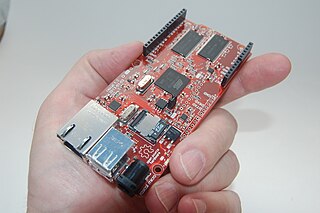 W
WRascal is a single-board computer. It is designed by Brandon Stafford and sold by Rascal Micro LLC in Somerville, Massachusetts.
 W
WRaspberry Pi is a series of small single-board computers developed in the United Kingdom by the Raspberry Pi Foundation in association with Broadcom. Early on, the Raspberry Pi project leaned towards the promotion of teaching basic computer science in schools and in developing countries. Later, the original model became far more popular than anticipated, selling outside its target market for uses such as robotics. It is now widely used in many areas, such as for weather monitoring, because of its low cost, modularity, and open design.
 W
WRed Pitaya is a project intended to be alternative for many expensive laboratory measurement and control instruments. It is known as open-source, though the hardware design is proprietary.
 W
WSAM Labs is a startup that makes app-enabled construction kits, designed for people of all ages to learn STEM, play, and create with technology and the Internet of Things. Founded by Belgian born CEO Joachim Horn, the company works out of their headquarters in East London.
 W
WThe Snowball is a Nano-ITX-form factor single-board computer using the NovaThor A9500.
 W
WSunPCi is a series of single-board computers with a connector that effectively allows a PC motherboard to be fitted in Sun Microsystems SPARC-based workstations based on the PCI architecture adding the capability for the workstation to act as a 'PC compatible' computer. The Sun PCi cards included an x86 processor, RAM, expansion ports, and an onboard graphics controller, allowing a complete Wintel operating environment on a Solaris system. The SunPCi software running on Solaris emulates the disk drives that contain the PC filesystem. The PC software running on the embedded hardware is displayed in an X window on the host desktop; there is also a connector on the edge of the board that can optionally be used to connect a PC monitor.
 W
WSystem Host Board is a term applied to a single-board computer meeting the PICMG 1.3 specification. PICMG 1.3 extended the previous PICMG specifications to continue support for PCI/PCI-X expansion cards as well as new support for PCI Express.
 W
WThe VIA APC is a low-cost ($49) single-board computer from VIA Technologies designed to run the Android operating system. It has been available for purchase since July 2012. Since January 2013 enhanced versions are available for purchase at a higher price.